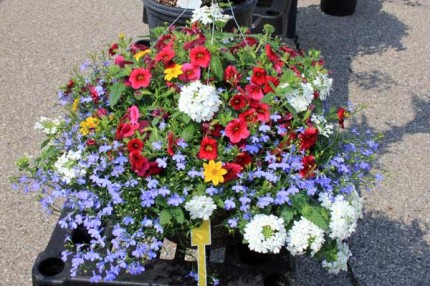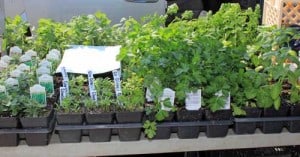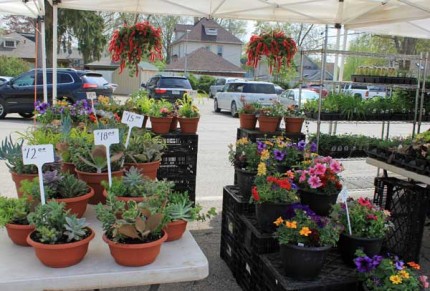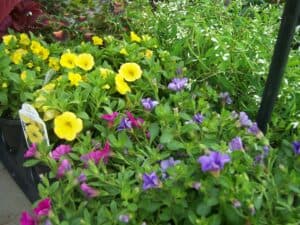
(Chelsea Update would like to thank Jennifer Fairfield, owner of The Garden Mill, for the information in this column. Part I, which looked at vegetables, ran Friday. )
Flower garden:
Pansies, primrose, ranunculus, snapdragons and stock can all be planted now. You take your chances when planting anything else just yet, even though the temps are warming up.
Hanging baskets and patio pots are coming in now, and there seems to be a lot of pent-up demand, as I’ve already been getting calls asking when we will be getting them. So, plan to get yours early in order to get the best selection, but also plan to bring them into your garage at night for a little while yet.
Remember, these plants have been in greenhouses, so aren’t going to like being shocked by the nighttime temperatures that we will still be getting for the next few weeks (We will be bringing them in at night at the store – and yes, it is one of our least favorite chores.)

At this time of year, I make a minimum of one trip per week to our growers, so if there is something in particular you are looking for, just ask – I can keep an eye out for you while I’m wandering through the greenhouses. And keep in mind, all of our plants are grown locally, so by buying from us, you are supporting two local businesses.
It should be safe to start planting most annuals out in the garden over the next few a few weeks. Again, keep an eye on the temperatures, and have row covers handy if we get a late frost after you have done all that hard work, so you don’t lose them.
Perennials
Some perennials can be planted out now. Generally, if it’s been hardened off (not living in a greenhouse, but actually outside), then you should be able to plant it now. With perennials, it’s best to get plants that aren’t yet in bloom so that they can work on putting down roots instead of concentrating on blooms right away. If you just have to have something you find at a greenhouse, by all means, buy it. But get it used to the temperatures gradually.
Put it outside during the heat of the day, and bring it in at night. Then gradually increase the amount of time it’s out so that it is getting a taste of the morning and evening chills. Over the course of a week or two, you can build it up to being out overnight, and then can plant it in its forever home.
Summer-flowering perennials that have outgrown their space in your garden should be divided or moved early in the month, if you haven’t already done so. Waiting too long can lead to stress when the temperatures start to really rise. Don’t move early-bloomers now, though. They are using all their energy to put out flowers, and don’t have enough to spare for trying to put down roots. Wait until after they have bloomed (or better yet, wait until early fall) to divide and transplant these plants. If you really have to move plants that are blooming now (or are about to), cut the blooms or buds off so that the plant can work on roots instead of blooms in its new home. You might be losing the pretty flowers this season, but the plant will be in much better shape to put on a great show next year.
Compost:
Work compost into the top few layers of soil in your beds, being careful not to disturb roots, and put down a new layer of mulch, once the soil has warmed up, to help keep moisture in and keep soil temps consistent. Don’t put mulch down too early though, or you will keep the soil temperature cooler longer, which can stunt growth. Also, don’t just pile mulch on top of the stuff that is already there.
The likelihood is that last year’s mulch is matted down from the snow over the winter, and piling new mulch on top of that will just add another layer for water and air to have to get through. Use a garden fork to fluff up the existing mulch first, before putting any new mulch down to give air and water a chance at getting down to the soil, and therefore the roots of your plants.
Trees and shrubs:
Now is the time for planting trees and shrubs. Planting them now gives them time to get established before the really warm and dry weather sets in. Just make sure to keep them very well watered after you plant them.
When choosing trees and shrubs, ask whether they have overwintered outside here in Michigan, or if they were just brought in from somewhere south of us or spent the winter in a greenhouse. Trees that spent the winter indoors or were raised in more temperate climates may not do as well as those that have already experienced one of our winters. They may also be too far ahead for our current temperatures. Leaves or blossoms that are further along than the trees and shrubs in your yard are not a good sign – they may not survive a sudden dip in temperatures like the one we had just last week.
Prune forsythia and other early-flowering shrubs as soon as they have stopped flowering. Keeping them properly pruned will help keep them from getting leggy and helps which translates into more flowers.
As your trees and shrubs begin to bud and leaf out, you may notice some damage due to the harsh weather this winter, if you haven’t already. Prune back dead and damaged branches, but if more of the plant is dead than alive, it may be time to replace. Two years of really miserable winter weather may just have been too much for some plants, especially ones that may be at the very northern edge of their cold-hardiness. We are technically in hardiness zone 6a, but the last two winters have been more like Zone 4.
Lawn:
Should you fertilize your lawn in the spring? The answer to that depends on your soil conditions, and the only way to know that is to have it tested. Without knowing what your soil needs, you could be wasting your money on the wrong fertilizer, or you may not need fertilizer at all.
Come in to the store for a do-it-yourself soil test, or get a more advanced soil testing kit from the MSU Extension, and get an in-depth analysis of your soil’s needs before you spend money on something that may not be helping your lawn.
If you haven’t started mowing yet, you probably will need to soon. Before the first mow, walk through your yard and pick up branches that may have been blown down, rocks that may have been plowed from your driveway, and other debris that may cause damage to your mower.
When you do mow, consider mowing higher than you might usually. MSU extension now recommends mowing no lower than 3.5” to maintain a healthy lawn. That may sound high, but there are lots of really good reasons for it. Their “Mow High for Weed and Grub Control” publication explains how mowing higher can help shade out weeds, retain moisture, and promote healthy root systems in your lawn, which can help with grub control. They also provide more tips on how to achieve a low-maintenance healthy lawn here.
For the Birds:
Have you put out your hummingbird and oriole feeders yet? If not, do it now. Ruby-throated hummingbirds were first spotted in southeast Michigan in mid-April, and have now been seen as far north as the Thumb area. Click here has a great graphic showing the northward migration of these beauties.
Likewise, Baltimore orioles are back. While they are looking for mates and building nests, they are likely to show up at your feeders. Once they have babies to tend to, they will be looking for protein-rich insects to eat and feed to their young, and aren’t likely to show up at your feeders.
So the only time to see these guys at your feeders is now and possibly in the late summer or early fall, as they get ready to head south again. Types of food for orioles include nectar, oranges and grape jelly, as well as orange-flavored suet. By the way – red-bellied woodpeckers also love oranges and orange-flavored suet.
Be sure to clean your nectar feeders out at least once a week, and more often in hot weather.
For all of the birds gracing your yard with their presence, be sure to put out and keep birdbaths full. Birds are wonderful insect eaters, and giving them water sources will help keep them hunting for their favorite meals in your yard. Seems like a great trade-off to me.
Bats are also great natural insect controllers. To get them into your yard, put up bat houses. Bats eat lots of the insects we don’t like in our gardens, and are also great for mosquito control.
If you have a pond, lake, stream or other sizeable water feature, you are likely to have bats visiting, so why not get them to stick around. The Michigan DNR offers information on bats and bat houses in their Landowner’s Guide to Bats.
Below are some quick tips:
- Place your bat house within ¼ mile of a water source.
- Place your bat house on a building, post or pole, facing south or southeast, at least 5 feet high.
- Don’t place your bat house on your house – it encourages them to enter your house as the colony grows and outgrows their house.
- Don’t place your bat house on a tree, as the shade of the tree can keep the house too cool.
- Don’t be discouraged if the bats don’t take up residence right away – it may take some time for them to decide to move from their current home.
Speaking of homes near a water source, if you have a sizeable water feature, a wood duck house is a great way to provide shelter for a beautiful creature that can be lots of fun to watch.




















